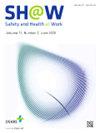韩国工薪阶层不稳定就业的特征和社会人口分布——基于总分的多维分析方法
IF 3.5
3区 医学
Q1 PUBLIC, ENVIRONMENTAL & OCCUPATIONAL HEALTH
引用次数: 0
摘要
导言:全球对不稳定就业问题的关注与日俱增。我们旨在采用总分法分析不稳定就业的特征和社会人口分布:为了对不稳定就业进行操作,我们利用了韩国工作条件调查的数据,重点关注三个不同的维度:就业不稳定、收入不足以及缺乏权利和保护。通过构建一个从-16 到 2 分的总分量表(分数越低,就业不稳定程度越高),我们测量了韩国工薪族的就业不稳定程度。为了根据调查对象的特征比较就业不稳定程度,我们采用了 Wilcoxon 秩和检验法:我们对 38 432 名工人进行了加权分析。总体样本的总分中位数(Q1,Q3)为-3(-6,-1)。女性的总分中位数低于男性(男性:-2;女性:-5;p p p p 结论:我们的研究结果表明,某些弱势群体,如妇女、年轻人或老年人、教育程度低的工人、护理人员或低技能初级工人,过多地面临就业高度不稳定的问题。需要采取积极的政策干预措施来提高弱势群体的就业质量。本文章由计算机程序翻译,如有差异,请以英文原文为准。
Characteristics and Socio-Demographic Distribution of Precarious Employment Among Korean Wage Workers: A Proposition of Multidimensional Approach Using a Summative Score
Introduction
There is a growing global interest in the issue of precarious employment. We aimed to analyze the characteristics and socio-demographic distribution of precarious employment using a summative score approach.
Methods
To operationalize precarious employment, we utilized data from the Korean Working Conditions Survey and focused on three distinct dimensions: employment insecurity, income inadequacy, and a lack of rights and protections. By constructing a summative scale ranging from -16 to 2, with lower scores indicating higher precariousness, we measured employment precariousness among Korean wage workers. To compare employment precariousness according to survey participant characteristics, we employed the Wilcoxon Rank Sum Test.
Results
We analyzed a weighted number of 38,432 workers. The overall sample showed a median (Q1, Q3) summative scale score of -3 (-6, -1). The median summative score was lower for women compared to men (men: -2; women: -5; p < 0.001), as well as for young or older workers compared to middle-aged workers (young: -4; middle-aged: -2; older: -5; p < 0.001). Similarly, workers with lower educational levels (middle school or below: -8; high school: -5; college or above: -2; p < 0.001) and non-white collar workers (blue collar: -5; service/sales worker: -6; white collar: -2; p < 0.001) experienced higher levels of employment precariousness.
Conclusion
Our findings indicate that certain vulnerable groups, such as women, young or older adults, workers with low educational attainment, and caregiving or low-skilled elementary workers, are disproportionately exposed to high employment precariousness. Active policy interventions are needed to improve the employment quality of vulnerable groups.
求助全文
通过发布文献求助,成功后即可免费获取论文全文。
去求助
来源期刊

Safety and Health at Work
Social Sciences-Safety Research
CiteScore
6.40
自引率
5.70%
发文量
1080
审稿时长
38 days
期刊介绍:
Safety and Health at Work (SH@W) is an international, peer-reviewed, interdisciplinary journal published quarterly in English beginning in 2010. The journal is aimed at providing grounds for the exchange of ideas and data developed through research experience in the broad field of occupational health and safety. Articles may deal with scientific research to improve workers'' health and safety by eliminating occupational accidents and diseases, pursuing a better working life, and creating a safe and comfortable working environment. The journal focuses primarily on original articles across the whole scope of occupational health and safety, but also welcomes up-to-date review papers and short communications and commentaries on urgent issues and case studies on unique epidemiological survey, methods of accident investigation, and analysis. High priority will be given to articles on occupational epidemiology, medicine, hygiene, toxicology, nursing and health services, work safety, ergonomics, work organization, engineering of safety (mechanical, electrical, chemical, and construction), safety management and policy, and studies related to economic evaluation and its social policy and organizational aspects. Its abbreviated title is Saf Health Work.
 求助内容:
求助内容: 应助结果提醒方式:
应助结果提醒方式:


